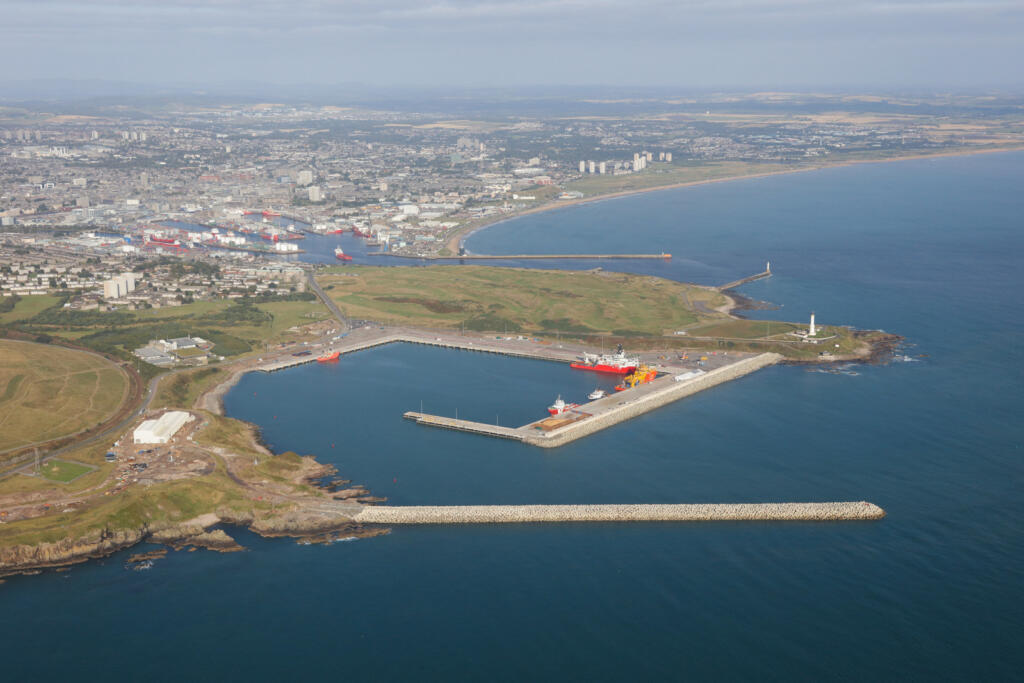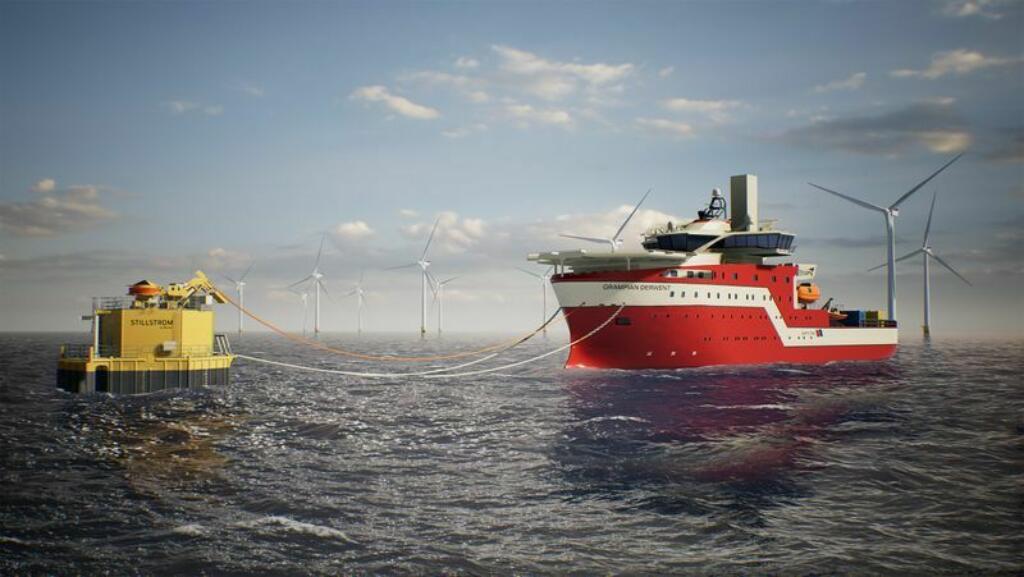
Seas of Change: Ports at the Forefront of Energy Transition

Ports in the UK such as Aberdeen serve as vital gateways to the offshore energy supply chain, providing services from surveying and construction to operational support, maintenance and decommissioning for oil and gas platforms and renewable energy installations all around the UK coastline.
Ports and vessels: the lifeblood of offshore energy
Vessels, moving 84.5 million tonnes of energy related cargo in 2022, are the lifeblood of the offshore energy industry, supporting tens of thousands of jobs. In the North East of Scotland, Europe’s Energy Capital, more than 6,500 vessels (more than 580 unique vessels) call annually to Port of Aberdeen for offshore energy operations, with the port serving as a vital marine logistics hub throughout the energy project's lifecycle. Yet, as the drive to net zero gathers pace, curbing vessel emissions remains challenging. Developments like shore power and low or zero carbon fuels offer options for emission reduction, posing both challenges and opportunities from a port's perspective.
The environmental imperative
Since its inception in 1967, the UK offshore energy industry has produced approximately 45 billion barrels of oil equivalent (BBOe) from the UK Continental Shelf (UKCS). This has maintained the country’s energy security, while keeping our homes warm, our country moving and creating hundreds of thousands of highly skilled jobs across the UK.
In the context of climate change, there's a pressing need for global transformation. In 2019, the UK took a pioneering step as the first major economy to commit to achieving net zero emissions by 2050, a legally binding and leading target. Acknowledging this urgency, the UK offshore energy industry swiftly supported the government's net zero objectives, establishing the North Sea Transition Deal (NSTD). This agreement is designed to change the nature of oil and gas production in the UK by halving greenhouse gas emissions from production activities by 2030, progressing towards net zero emissions by 2050.
Vessel emissions are accounted for as part of the supply decarbonisation strand of the NSTD. The Deal focuses on immediate emissions reductions, and outlines measures such as operational process optimisation, investments in innovative technologies, equipment upgrades, and the phasing out of high emission assets to comprehensively address vessel emissions.
Shore power advancements
Decarbonising port infrastructure and vessels is integral to the UK's pursuit of net zero emissions. Shore power is considered the leading solution to reduce vessel emissions at berth, showcasing high technological readiness while ensuring adaptability for hybrid or fully electric vessels in the future. This approach promises reduced CO2 emissions and diminished noise pollution.
Shore power encompasses onshore electrical infrastructure, vessel electrical systems, and seamless connection mechanisms for safe and uninterrupted power transmission. This involves onboard systems for powering essential vessel equipment and automated processes for efficient power transfer between the vessel's power plant and the onshore source.

Shore Power components
Vessel emissions have historically been hard to abate, however, Port of Aberdeen is taking significant and sustained action to make this a reality. The port’s Clean Maritime Demonstration Competition Round One project revealed that 78% of CO2 emissions in the port stem from vessels at berth, prompting a significant focus on shore power implementation at seven berths. Projections suggest an annual mitigation of 3,100 tonnes of CO2 equivalent and substantial reductions in local noise and air pollution, and inhalable particulate matter (PM1, PM2.5 and PM10), following the full rollout of shore power and subsequent decarbonisation of the UK grid.
Capital costs for shore power for ports are high and need to be recouped through electricity sales. However, this is challenging due to the current misalignment of economic incentives. Collaboration and funding from public and private sectors remains crucial to realising this initiative and scaling up emissions reductions, aligning with Port of Aberdeen’s Net Zero Strategy and supporting supply chain emissions reduction efforts.
Port of Aberdeen's multimillion pound 'Shore Power in Operation' initiative – a consortium between Port of Aberdeen and Connected Places Catapult, DOF Subsea, Tidewater Marine UK Ltd, OSM Thome, The University of Manchester’s Tyndall Centre, and supported by major energy operators – represents Scotland's inaugural large scale landside and vessel side shore power system. Scheduled for completion by March 2025, the project will introduce shore power facilities at seven berths on Albert and Mearns Quays in the port's North Harbour, reducing emissions from vessels utilising shore power provisions by over 80% at berth compared to traditional marine fuel, resulting in savings of 62,000 tonnes of CO2 equivalent over two decades.
This pioneering project serves as a catalyst for broader adoption of green shore power across the port's North and South Harbours, potentially cutting total emissions at berth by 78%, equivalent to an annual reduction of 34,000 tonnes of CO2 equivalent.

Port of Aberdeen's North Harbour
Low and zero carbon fuels
Low and zero carbon fuels play a pivotal role in the decarbonisation journey of the offshore energy industry. Diversifying the energy mix with renewable and sustainable fuels and transitioning to low or zero carbon fuels will be essential to mitigating the adverse effects of climate change.
Facilitation of future low or zero carbon fuels will require stringent regulatory compliance across the industry. Forecasting the demand of fuel types will help industry comply with evolving environmental standards and regulations. Similarly, investing in research and development of alternative fuels is required to drive forward technological innovation and advancements. These combined will lead to more efficient and cost effective low or zero carbon fuel solutions in the future.
The potential of alternative fuels in the decarbonisation journey is significant. However, successful integration faces challenges such as scalability, infrastructure development, cost competitiveness and technology maturity and social acceptance. Nevertheless, with continued advancements, supportive policies and collaborative efforts among governments, industries and research institutions, alternative fuels have the potential to play a pivotal role in the decarbonisation of the offshore energy industry, contributing to a more sustainable and environmentally friendly future.
Challenges and opportunities for change
Decarbonising vessel supply chains poses challenges across economic, technological, and logistical fronts. Transitioning to low or zero emission vessels demands advanced technologies like hydrogen fuel cells, batteries, or alternative fuels such as ammonia or methanol. However, developing these technologies to be both efficient and cost effective for the global fleet remains a substantial hurdle. Retrofitting current fleets or constructing ecofriendly vessels necessitates significant investments and time from operators. Similarly, energy density variations among alternative fuels can limit vessel range or payload capacity, demanding future solutions that don't compromise operational efficiency.
Technological advancements like autonomous vessels and leveraging data analytics, AI and machine learning can optimise vessel performance, reduce costs and improve safety. Electric or hybrid propulsion systems offer emission reductions and cost efficiencies, especially with advancements in battery technology. Innovations in design, such as Artemis Technologies’ ground breaking 100% electric high speed Artemis EF-24 Crew Transfer Vessel (CTV), represents a significant leap forward and sets a new benchmark for performance, fuel efficiency and carbon emissions reductions.
“Strong partnerships, substantial investments, and a steadfast commitment to sustainability will be pivotal in effectively decarbonising vessel supply chains.”
Establishing infrastructure supporting sustainable vessel operations, including shore power facilities, renewable energy sources, alternative fuel stations and efficient cargo handling, is crucial. However, addressing these challenges and seizing future opportunities for innovation demands a collaborative effort among offshore and maritime industries, policymakers, investors, and technology developers. Strong partnerships, substantial investments, and a steadfast commitment to sustainability will be pivotal in effectively decarbonising vessel supply chains.
Offshore energy vessel decarbonisation projects
Stillstrom and North Star have signed a Memorandum of Understanding (MoU) to accelerate offshore charging and vessel electrification for Service Operation Vessels (SOVs). Under the terms of the MoU, Stillstrom will leverage its extensive experience in offshore charging infrastructure to demonstrate how their charging solutions can benefit North Star’s growing SOV fleet. This will enable vessels to recharge using wind energy while operational. North Star will provide valuable insights into vessel integration operations with Stillstrom’s charging units. This project promotes the adoption of hybrid and fully electric vessels and charging solutions in the offshore wind sector, enabling cleaner offshore operations and improved vessel efficiencies.

Image courtesy North Star
Additionally, as a consortium partner with Bibby Marine, Port of Aberdeen is collaborating on the construction of the world's first zero emission electric Service Operation Vessel (eSOV). This vessel, equipped with a robust battery system and dual fuel methanol engines, underscores UK leadership in technology and design while significantly reducing emissions and costs. Nigel Quinn, CEO of Bibby Marine, highlighted the vessel's transformative potential for the industry and emphasised its pivotal role in positioning the UK as a premier hub for green technology, showcasing British innovations and enhancing local content.
Anchoring a sustainable future
The decarbonisation of ports and vessels stands as the cornerstone to a sustainable future for the UK’s offshore energy industry. The pivotal role of ports, serving as essential gateways for international trade and multimodal hubs in the energy supply chain, cannot be overstated. As the UK strides towards achieving net zero emissions by 2050, ports are at the forefront of this transformative journey, embodying the epicentre of the nation's energy transition and the broader ecosystem of the UK's energy landscape.
“The decarbonisation of ports and vessels stands as the cornerstone to a sustainable future for the UK’s offshore energy industry.”
The commitment to decarbonise ports and vessels represents a fundamental shift, not only in reducing emissions but also in steering the course toward environmentally responsible practices within the offshore energy and maritime industries. As ports embrace this transition and spearhead initiatives to decarbonise vessels and operations, they set the stage for a significant leap towards a cleaner more sustainable future for the UK's offshore energy sector.




